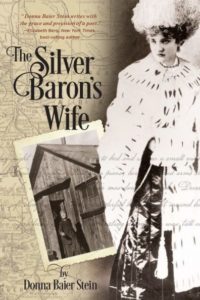A remarkable woman dares to take hold of her own life at a time when that was the exception rather than the rule. The Silver Baron’s Wife follows the story of Elizabeth Tabor from young girl, to newlywed, to divorcee and working woman, to the wealthy second wife of a silver baron. Lizzie’s unconventional life is presented against the backdrop of the American west, and the mining booms and busts that feature predominantly during this time in history. Seamlessly blending fact and fiction, Donna Baier Stein weaves Lizzie’s story into a rich tale of love and loss, triumph and tragedy, courage and compassion. I’m pleased to welcome Donna to Book Club Babble today!
Tabitha Lord: One of my favorite things about being a writer is the ability to see a story anywhere. But, in order for me to actually start putting pen to paper, something needs to grab me and hold on. What was it about Elizabeth Doe Tabor that grabbed you and wouldn’t let go?
Donna Baier Stein: The amazing contrasts in her life. I saw two photographs of her – one of her in a long ermine coat, obviously a wealthy woman, and a second of her, older, standing in front of a shack dressed eccentrically in an man’s coat and unflattering hat. I could hardly believe these two photographs pictured the same woman. I wanted to understand who this woman was… and how her life journey had taken her to two such disparate places. I was also intrigued by the existen ce of thousands of her written-down dreams and the thread of spiritual searching that ran through her life.
ce of thousands of her written-down dreams and the thread of spiritual searching that ran through her life.
TL: Often the devil is in the details, so to speak, and I find that with historical fiction especially, I can be pulled right out of the story if something doesn’t ring true. With The Silver Baron’s Wife, you’ve created a rich, authentic reading experience. Can you talk about how much time and energy went into researching this novel?
DBS: Well, it’s somewhat embarrassing, but I spent many years researching and writing this book. I read nonfiction books about Lizzie, Horace, and Augusta, and I saw the American opera The Ballad of Baby Doe. I traveled to Denver and Leadville several times, photocopying many of her dreams at the Denver Public Library and visiting the Matchless Mine. The more I learned, the stronger my interest grew. I worked on the novel in fits and starts, though, while I was also raising children and working as a freelance copywriter.
TL: At what point did Lizzie’s character become fully formed in your mind? When did you find her voice?
DBS: I found her voice when I started writing in first person, imagining Lizzie’s last days at the Matchless Mine as an old woman alone. These monologues poured out of me, and they were truly my favorite parts of the book to write. Initially I interspersed monologues from the last week of her life throughout the chapters. At the end, I combined those so that other than the prologue, the narrative arc is chronological. I identified with Lizzie in many ways, and her voice came very naturally to me.
An agent once suggested I rewrite the book in third person limited. I tried that but it simple didn’t resonate with me the way those first person pages did. I wanted to speak in Lizzie’s voice. I felt, somewhat mysteriously, as though I knew what she wanted to say.
TL: When writing about actual events and people, a balance must be achieved between presenting facts and telling a good story. Were there any parts of the story where you needed to sacrifice historical accuracy for the sake of moving the plot along?
DBS: I initially thought that writing a novel about Lizzie Tabor would be easy because so many dramatic events happened in her life. Voila, there’s a plot, I thought naively. I quickly learned that I could not just plop down the events as they happened but had to weave a real narrative arc. Obviously I made up conversations and added minor characters but the bulk of the book holds true as far as events and dates though I did decide to leave out certain things – a stillborn child, a friendship with a tailor named Jake Sandusky, more information about Lizzie’s daughters, each of whom could have a novel written about them.
TL: In so many ways Lizzie is a woman ahead of her time. For example, she marries outside her faith for the sake of love, she works in a mine in the place of her injured husband, and she files for divorce rather than accept a dysfunctional relationship. Later, she has an affair with a married man, which hastens the demise of his marriage. This particular choice is still frowned upon in today’s society, yet you were able to present both Lizzie and Horace with balance and sympathy. How did you decide on your approach to writing about their relationship?
DBS: For some reason I never saw Lizzie as a manipulative “home-wrecker.” Nor did I see Horace in a bad light. Based on their letters to each other and on the fact that she remained with him even after he lost his wealth, I believe they truly loved each other. When I was on book tour recently in Colorado, I heard more tales about how wonderful and kind Horace’s first wife, Augusta was. I’m sure she was. But I was writing a book about Lizzie, and to my mind, earlier versions of her story had focused solely on the scandalous love triangle between Lizzie, Augusta, and Horace. I thought Lizzie deserved more. There were so many other aspects of her life that were compelling and, as you say, bucked the social expectations of the day. And if Lizzie had been only a “gold digger,” if she had not remained with Horace after he lost his fortune, she would have been a much less sympathetic character in my mind. When Horace died, she was still young and beautiful and could easily have remarried, but she chose not to. This said something to me about her love and loyalty.
TL: After Horace’s death, Lizzie lives for another thirty-five years, working to keep their silver mine going. You don’t spend much time on this part of her life. Can you talk a little about this choice?
DBS: I definitely saw those years as a rather quick sequence. Her life during those years was filled with so many losses, beginning with Horace’s death and proceeding through the loss of her daughters. Judging by her dreams, she withdrew more and more into her interior life, into her prayers, dreams, and spiritual visions. I wanted to portray this unravelling, or opening, of her mind, rather than just present a sequence of chronological events during those 35 years.
TL: I found the last few chapters of the book to be very compelling. At the end of Lizzie’s life we experience her loneliness and loss, but also her peace and acceptance. Was writing her death scene cathartic for you?
DBS: Yes, definitely. Throughout the book, Lizzie balances between faith and doubt. I wanted Lizzie to be at peace with her faith at the end. I hope she was. She was so alone. All she had were the appearances of her lost beloved family members in her dreams, and her visions of Jesus and Mary and others. I wanted to imagine what that might have been like for her – having lost all normal connections with those she loved, but hanging on to some kind of deeper connection fueled only by faith. I liked the idea of her no longer being defined as wife, mother, child, sister, neither old nor young, but purely “returning to source” beyond the roles she had played during her earlier years.
TL: Let’s talk about you! You’ve written award winning short fiction as well as this full-length novel, and you teach some fiction writing classes. Have you always been a writer? And if not, can you discuss your path from there to here?
DBS: I’ve always wanted to be a writer. In grade school I wrote a little story called “Melissa in Book World” about a girl who lived underwater. For better or worse, I think I’ve often been that Melissa! I went to graduate school in Literature but at the time didn’t think I could be a professor. So I took a job as a direct marketing copywriter and soon started freelancing, thinking I’d have more time to work on my own writing. For many years I went back and forth, doing copywriting jobs, writing stories and poems, working on the novel.
TL: Are you currently at work on something new?
DBS: I’m very close to finishing a collection of stories based on lithographs by the Midwestern artist Thomas Hart Benton. I’ve had eight such stories published in good literary journals. With two more, I’ll have a manuscript ready to send out for publication. I’ve also started a new historical novel, set mostly in Manhattan in the late 19th century. It’s in a very early stage so I’d rather not talk too much about it yet! I also have a collection of poems I’m readying for submission.
 Donna Baier Stein is the author of Sympathetic People (Iowa Finalist Award Winner and 2015 IndieBook Awards Finalist) and Sometimes You Sense the Difference. An earlier version of her novel The Silver Baron’s Wife won the PEN/New England Discovery Award. Her writing has earned three Pushcart nominations. She has received a Bread Loaf Scholarship, Johns Hopkins University MFA Fellowship, Allen E. Ginsberg Poetry Prize, grants from the New Jersey Council on the Arts and Poetry Society of Virginia, a Scholarship from the Summer Literary Seminars, and more. Donna’s stories and poems have appeared in Virginia Quarterly Review, Confrontation, Prairie Schooner, New York Quarterly, Washingtonian, New Ohio Review, Ascent, Puerto del Sol, and many other journals as well as in the anthologies I’ve Always Meant to Tell You (Pocket Books), To Fathers: What I’ve Never Said (featured in O Magazine), Men and Women: Together and Alone from Spirit That Moves Us Press.
Donna Baier Stein is the author of Sympathetic People (Iowa Finalist Award Winner and 2015 IndieBook Awards Finalist) and Sometimes You Sense the Difference. An earlier version of her novel The Silver Baron’s Wife won the PEN/New England Discovery Award. Her writing has earned three Pushcart nominations. She has received a Bread Loaf Scholarship, Johns Hopkins University MFA Fellowship, Allen E. Ginsberg Poetry Prize, grants from the New Jersey Council on the Arts and Poetry Society of Virginia, a Scholarship from the Summer Literary Seminars, and more. Donna’s stories and poems have appeared in Virginia Quarterly Review, Confrontation, Prairie Schooner, New York Quarterly, Washingtonian, New Ohio Review, Ascent, Puerto del Sol, and many other journals as well as in the anthologies I’ve Always Meant to Tell You (Pocket Books), To Fathers: What I’ve Never Said (featured in O Magazine), Men and Women: Together and Alone from Spirit That Moves Us Press.


